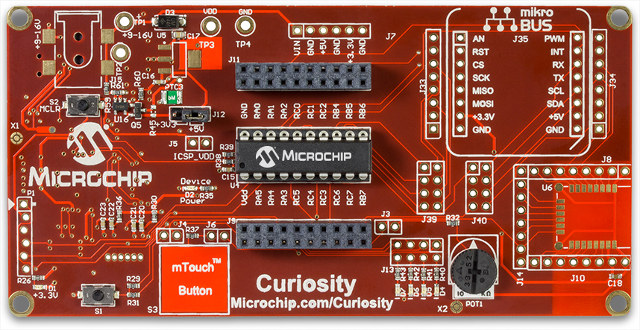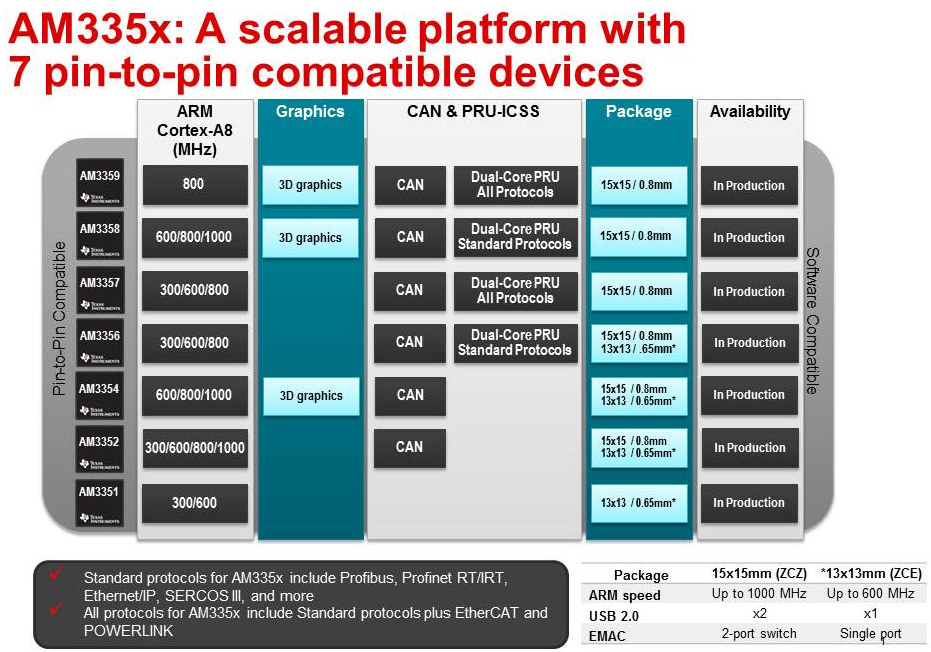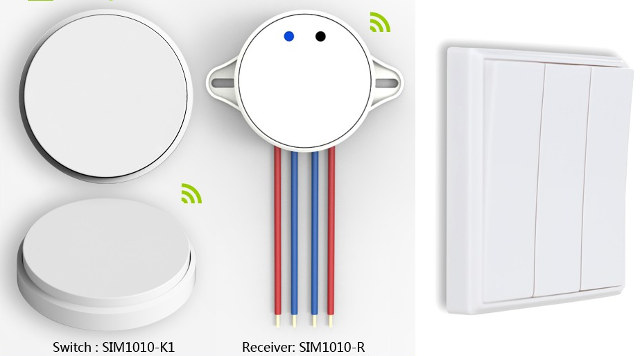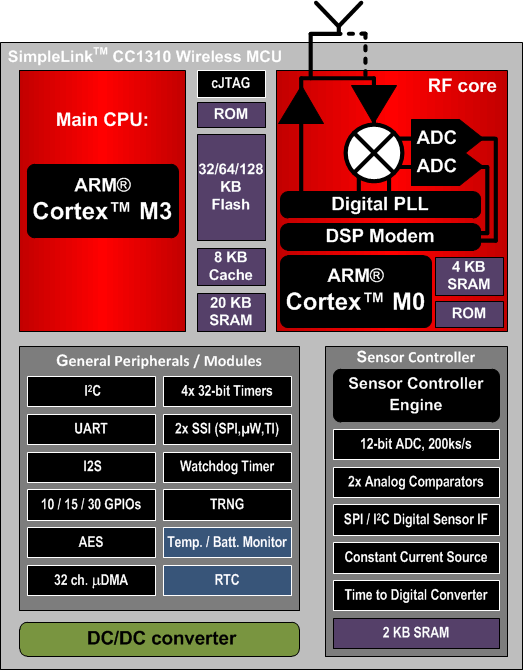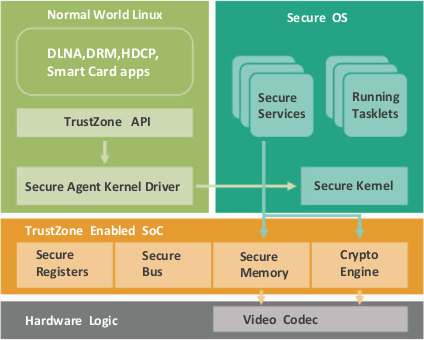I’ve just found out Microchip had introduced Curiosity development board a little while ago, in order to let students and others experiment with their 8-bit PIC DIP MCUs, and including MikroElectronika Mikrobus footprint, an interface for Microchip RN4020 module to add Bluetooth Low Energy, as well as other headers and some extra features like buttons, and a potentiometer. Microchip Curiosity board specifications: MCU – PIC MCU socket for 8, 14, and 20-pin micro-controllers with PIC16F1619 pre-installed. Expansion mikroBUS Click Board footprint Microchip RN4020 Bluetooth Module Footprint USB – USB mini-B connector Misc – Master Clear Reset button, potentiometer, LEDs, mTouch button, push button Power Supply 5V via USB 9V using an external power supply (footprints only) 3.3V to 5V external power supply via TP3 and TP4 pins Dimensions – N/A There are over 160 MikroElektronika Click boars on the market now, but only seven are listed with code samples for […]
Texas Instruments Introduces Entry level Sitara AM3351 Cortex-A8 Processor
Texas Instruments Sitara AM335x processor are designed by industrial applications, and found in develompent board such as BeagleBone Black or BeagleBone Green, and the company has recently launched the new Sitara AM3351 Cortex A8 processor without 3D GPU, no PRU just like AM3352, but they’ve also canned the two CAN interfaces (sorry, I had to) in order to bring the cost lower, while keeping the processor software and pin-to-pin compatible with other AM335x processors available in 13×13 mm package. TI Sitara AM3351 CPU clock will also be limited to 300 MHz to 600 MHz with respectively AM3351BZCE30 and AM3351BZCE60 parts. It will only come with one Gigabit Ethernet port instead of up to two ports of other members of the family that are produced in 15x15mm package, and temperature range is limited to 0 to 90 C. Other features remain the same, and the processors will support TI-RTOS, Linux, Android, […]
GeekBox TV Box Unboxing and Development Kit Assembly Guide
GeekBox is both an Android TV box based on Rockchip RK3368 octa-core processor, and a Linux development kit thanks to the CPU module inside the device, a baseboard and various accessories. The company has sent me a review sample, as well as the accessories currently available. So today, I’ll have a look at the box, and show how to connect everything together. GeekBox TV Box Unboxing I’ve received two carton boxes via DHL, one with GeekBox itself, and the other with some accessories. You could use GeeBox has a TV box, and forget about its development attributes, as the device comes with the usual accessories include a case, an HDMI cable, an infrared remote control, and a 5V/2A power supply. I was really surprised by how small it was compared to other 64-bit ARM TV boxes recently launched on the market, and looks very much like a small router with […]
DietPi is Lightweight, Easy to Use Debian Based Distribution for Raspberry Pi, ODROID, and Orange Pi Boards
Raspberry Pi, Hardkernel ODROID, and Orange Pi are some of the most popular and cost effective development boards on the market today, and one British developer, going under Fourdee nickname, has released a lightweight distribution called DietPi working for all Rasbperry Pi boards, ODROID-C1(+), ODROID-XU3/XU4, and Orange Pi PC, with Orange Pi 2 and Orange Pi Plus support coming soon, as well as a VMWare virtual machine also available for evaluation. The compressed downloads are about 80 to 100MB depending on the target, the image that can be dump with dd or Win32DiskImager requires a 1GB or greater micro SD card as the image itself is about 500MB large, Internet access (Ethernet or Wifi), and optionally a USB Drive to allow installation on a USB drive for better performance, which of course does not apply if you have an eMMC module with your ODROID board. The image also contains some […]
SimpleLink Battery-less Power Switch Leverages RF & Energy Harvesting Technologies
SimpleLink may be the name used by Texas Instruments for their wireless MCU family, but there’s also a Chinese company called SimpleLink Technology that develops wireless smart home solutions including battery-less power switches that communicate over sub GHz band to receivers using energy harvested from pressing the button(s) on the switch. They have different models with 1 to 4 buttons, and round and square shapes. Let’s have a look at SIM1010-K1 specifications: Switch Type – Push-Button; operating force: 7N; typical total travel: 4mm Number of Keys – 1 gang Power Mode: Self-Powered Control Distance – Up to 30 meters indoor (works though walls), 100+ meters outdoor Frequency Bands – 433/315/868/915MHz Lifetime – >200,000 times Connectivity – SimpleLink (most probably entirely unrelated to TI SimpleLink); +10dBm Tx power Operating Temperature: -25~70℃ Operating Humidity: 0~95%RH Dimensions – Ф 70 x 15.5 mm Weight – 44g That self-powered wireless switch will prevent the […]
TI SimpleLink CC1310 Wireless MCU Promises 20 Km Range, 20-Year Battery Life on a Coin Cell
Some LPWAN standards such as SigFox, LoRa, or nWave allows for transmission of data at low bitrate over several kilometers, and I’ve very recently featured Microchip’s LoRa modules and motes in this blog. So when Texas Instruments sent their December 2015 newsletter entitled Wireless MCU spans 20 km on a coin cell, I decided to have a look, and the company’s CC1310 wireless Cortex-M3+M0 MCU based on a proprietary sub GHz technology also claims to last 20-year on a coin cell for applications such as grid communication infrastructure and heat and water meters. SimpleLink CC1310 key features: Microcontroller – ARM Cortex-M3 @ up to 48 MHz with up to 128KB programmable flash, 8KB DRAM for cache/general purpose, 20KB Ultralow Leakage SRAM Sensor Controller – Ultralow power and autonomous; 16-Bit Architecture; 2KB of Ultralow Leakage SRAM for code and data RF core Cortex M0 core with 4KB RAM, and ROM Data […]
How to Upgrade SMA-Q Smartwatch Firmware
I’ve started testing SMA-Q smartwatch, and so far I’ve had lots of issues with Bluetooth connectivity. The watch can rarely pair with my Android smartphone, and I was unable to enable features like Anti-lost and Sedendary alerts as the app would always report there was no connection. The company has sent me instructions to upgrade the firmware, and it seems to have improved things a little. So first you need to install SMA Services app by scanning the QR code on the user’s manual, or download the apk by following this link. Once this is done you can register, or skip registration. Now go to Setting, and select Connect watch. You should see a circle as on the left side above reading Searching watch, then Bluetooth Connecting, before seeing a message the connection was successful. You’ll probably them want to tap on Upgrade app, before tapping on Firmware upgrade (local […]
Amlogic S905X and S912 Processors To Support 4K VP9, HDMI 2.0a, Built-in DAC and More
I had heard some news that Amlogic S912 was delayed, and even possibly canceled, while talks about a new S908 processor surfaced recently with support for VP9 up to 4K resolution. We now have some more details as I’ve received some more information about Amlogic product roadmap, and S908 should be renamed S905M [Update: The name will apparently be changed to S905X now, the saga continues…] Amlogic S905 Amlogic S908 / S905M / S905X Amlogic S912 CPU Quad core Cortex A53 @ up to 2.0 GHz Quad core Cortex A53 @ up to 1.5/2.0 GHz Octa core Cortex A53 @ up to 2.0 GHz GPU Penta-core Mali-450 up to 750 MHz High perf gaming GPU Memory 16/32-bit DDR3, LPDDR2/3 Up to 2GB, DDR2133 16/32-bit DDR3/4, LPDDR2/3 Up to 2GB, DDR2400 Storage NAND Flash@BCH60 eMMC 5.0, SD, Nor Flash Video Decoding 4Kp60 10-bit HEVC, 4Kp30 H.264 4Kp60 10-bit HEVC, VP9 4Kp30 […]


